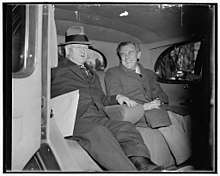Thomas Gardiner Corcoran
| Thomas Gardiner Corcoran | |
|---|---|
 Tommy Corcoran (right) and Harold L. Ickes leaving the White House after meeting with President Franklin D. Roosevelt (1938) | |
| Born |
December 29, 1900 Pawtucket, Rhode Island, U.S. |
| Died |
December 6, 1981 (aged 80) Washington, D. C., U.S. |
| Nationality | United States |
| Other names | "Tommy the Cork" |
| Alma mater |
Brown University (B.A.) Harvard Law School(LL.B.) |
| Occupation | Lawyer, lobbyist |
Thomas Gardiner Corcoran (December 29, 1900 – December 6, 1981) was one of several[1] advisors in President Franklin D. Roosevelt's brain trust during the New Deal, and later, a close friend and advisor to President Lyndon B. Johnson.
Early life
Corcoran was born in Pawtucket, Rhode Island, and educated at Brown University (where he was class valedictorian)[2] and Harvard Law School, graduating in 1926.
Early career
He clerked for Justice Oliver Wendell Holmes, Jr., at the United States Supreme Court in 1926 to 1927. In 1932, after practicing corporate law in New York City, Corcoran joined the Reconstruction Finance Corporation. When Roosevelt began to take notice of his efforts, Corcoran was given a wider range of responsibilities than his official position as assistant general counsel allowed.
Roosevelt administration
He organized administrative agencies for various New Deal programs and assisted in drafting such legislation as the Fair Labor Standards Act of 1938. A protégé of Felix Frankfurter, Corcoran was considered the leader of the "New Dealers," a group of young lawyers that became prominent within the Roosevelt administration in the wake of the renewed economic recession of 1937.[3]
_elevation_-_Scott-Grant_House%2C_3238_R_Street%2C_Northwest%2C_Washington%2C_District_of_Columbia%2C_DC_HABS_DC%2CGEO%2C242-1.tif.jpg)
Much of his work during the New Deal was in conjunction with Benjamin Victor Cohen. Together, Corcoran and Cohen were known as the "Gold Dust Twins" and were on the cover of Time Magazine's September 12, 1938 edition.[4] Nicknamed "Tommy the Cork" by Roosevelt, Corcoran was the outgoing yang to Cohen's shy and retiring yin.
Later life
After leaving the White House, Corcoran retained enormous influence in the administration, in part because of high appointees who owed their positions to him. Corcoran went into private practice as a lawyer along with former U.S. Federal Communications Commission (FCC) chief counsel William J. Dempsey, whom Corcoran had installed in that job in 1938. Dempsey and Corcoran managed the takeover of New York radio station WMCA for Corcoran's friend, Undersecretary of Commerce Edward J. Noble. That resulted in both an FCC and a congressional investigation.
Corcoran's work after leaving government service led him to be dubbed the first of the modern lobbyists.[5] Corcoran's phones were tapped by the federal government between 1945 and 1947.[6] The transcripts of the wiretaps were deposited in the Truman Presidential Library and not released to researchers until Corcoran's death. The evidence is that a Truman White House aide ordered the tap, but it was then rescinded by President Harry S. Truman.[7]
It is also alleged that Corcoran engaged in improper attempts to influence decisions of the Supreme Court.[8]
Family
Following in their father's footsteps, his son, Thomas G. Corcoran, Jr., attended Brown University and Harvard Law School (class of 1967), before founding the Washington, D.C., law firm of Berliner, Corcoran & Rowe.[9] A daughter, Margaret J. Corcoran, also graduated from Harvard Law School (class of 1965), and clerked for Associate Justice Hugo Black of the U.S. Supreme Court during the 1966 Term (the second woman to clerk), while continuing to assist her father at social events.[10]
His granddaughter, Sara Corcoran (Warner), earned her undergraduate degree and MBA from the University of Southern California.[11] She is a legal Journalist and is the publisher of The National Courts Monitor, a civil courts legal journal.[12]
References
- ↑ O'Donnell, Edward T. (2002). 1001 Things Everyone Should Know About Irish American History. New York, NY: Broadway Press. ISBN 0767906861. ISBN 978-0767906869.
- ↑ "Thomas Corcoran '22," Government and Politics, Brown Alumni Magazine, November/December 2000. Retrieved March 20, 2017.
- ↑ Alan Brinkley The End of Reform. Vintage Books. 1996. p. 51
- ↑ Time magazine, September 12, 1938
- ↑ McKean, David (2005). "Peddling Influence: Thomas 'Tommy the Cork' Corcoran and the Birth of Modern Lobbying" Hanover, NH: Steerforth Press. ISBN 9781586420864.
- ↑ Lichtman, Allan J. (February 1987). "Tommy the Cork: the secret world of Washington's first modern lobbyist", Washington Monthly.
- ↑ Harry S. Truman Papers: President's Secretary's Files
- ↑ Woodward, Bob; Armstrong, Scott (1979). The Brethren: Inside the Supreme Court. New York: Simon and Schuster. IBSN 1439126348, IBSN 9781439126349. Google books
- ↑ Biography for Thomas G. Corcoran, Jr., at Berliner, Corcoran & Rowe LLP. Retrieved 2017-01-20.
- ↑ "The Supreme Court: A Place for Women", Wilson Lecture presented by Justice Ruth Bader Ginsburg, Wellesley College, November 13, 1998 ("Black was not entirely pleased with Margaret's performance. He thought she didn't work hard enough. One time, for example, she told him she couldn't review 35 cert. petitions (petitions for Supreme Court review) over the weekend, because of plans to attend VIP dinners with her father. She was, in these extracurricular activities, a dutiful daughter. Corcoran was a widower and sometimes needed a substitute for a spouse at special events.") Retrieved 2017-01-20.
- ↑ "Biography - Sara Warner". HuffPost. Retrieved 15 August 2017.
- ↑ "The National Courts Monitor". National Courts Monitor. Retrieved 15 August 2017.
External links
![]()